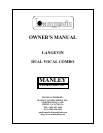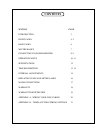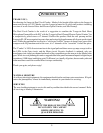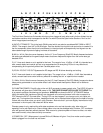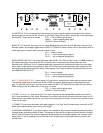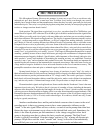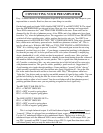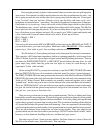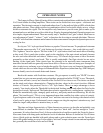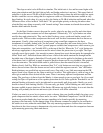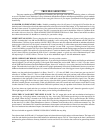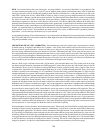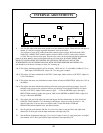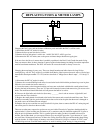
4
OFF
OFF
POWER
POWER
ON
ON
IN
IN
BYPASS
BYPASS
INPUT
INPUT
H.F.
H.F.
L.F.
L.F.
12 KHz
12 KHz
EQ IN
EQ IN
80
80
Hz
Hz
80
80
Hz
Hz
EQ IN
EQ IN
12 KHz
12 KHz
L.F.
L.F.
H.F.
H.F.
INPUT
INPUT
40
40
Hz
Hz
ATTENUATE
ATTENUATE
8
8
KHz
KHz
-10
-10
+10
+10
+10
+10
-10
-10
PHANTOM
PHANTOM
-10
-10
+10
+10
+10
+10
-10
-10
8
8
KHz
KHz
40
40
Hz
Hz
ATTENUATE
ATTENUATE
REDUCTION
REDUCTION
GAIN
GAIN
OUTPUT
OUTPUT
METER
METER
REDUCTION
REDUCTION
OUTPUT
OUTPUT
METER
METER
REDUCTION
REDUCTION
REDUCTION
REDUCTION
GAIN
GAIN
LINK
LINK
SEP
SEP
INPUT
INPUT
DIRECT
DIRECT
INPUT
INPUT
DIRECT
DIRECT
by Manley Laboratories Inc.
by Manley Laboratories Inc.
(PULLON)
(PULLON)
(PULLON)
(PULLON)
PHANTOM
PHANTOM
LIMITER
LIMITER
DUAL VOCAL COMBO
DUAL VOCAL COMBO
EQ OUT
EQ OUT
EQ OUT
EQ OUT
BYPASS
BYPASS
IN
IN
A B C D E F G H I H G F E D C B A
J K L M N O P 0 N M L K J
The Dual Vocal Combo has 2 channels which are mirror images of each other and is further divided into top
and bottom sections which correspond to the Mic Pre with EQ and the Opto-Limiter Sections. Don't let the
mirror image aspect confuse you!
A) INPUT ATTENUATE. This is the basic GAIN control which can also be considered MIC GAIN or INPUT
LEVEL. The range is from "off" to 50 dB of gain. Don't be afraid of turning this knob as loud as is needed. It is
the first component (other than the mic transformer) in the signal path so exceptionally loud signals can be
attenuated enough to prevent clipping in almost all situations.
B) 80 Hz / 40 Hz. Sets the corner frequency for the L.F (Low Frequency) Shelf EQ. Mostly frequencies below
the setting get affected but the gentle slope means that some frequencies higher than the corner also get
boosted or cut.
C) L.F. How much boost or cut is applied to the lows. The range is from -10 dB to +10 dB. It is intended as a
safe, smooth basic tone control and not as a comprehensive 'do everything' EQ but is very effective at
compensating for the proximity effect from Cardioid pattern mics.
D) EQ IN / EQ OUT. EQ OUT Bypasses the EQ stage and EQ IN allows boosting and cutting.
E) H.F. How much boost or cut is applied to the highs. The range is from -10 dB to +10 dB. Also intended as
a safe, smooth basic tone control and very effective for adding that 'air' or 'sparkle' when needed.
F) 12kHz / 8 kHz. Sets the corner frequency for the H.F (Low Frequency) Shelf EQ. Mostly frequencies above
these points get boosted or cut but some effect is still heard below these points. Watch out for sibilance
problems.
G) PHANTOM POWER. Puts 48 volts on the mic XLR connector to power certain mics. The LEDS (H) next to
the switches will glow when PHANTOM power is ON. THIS SWITCH MUST BE PULLED TO TOGGLE.This
is to prevent accidents like blowing your speakers. ALWAYS turn down the INPUT ATTENUATE before
hitting this switch. Mic signals are typically one hundredth of a volt and phantom is 48 volts so expect it to
POP unless the INPUT is turned down. The big POP can also happen if you change a mic, mic cable, mic
patch, etc. Turning down the monitors, headphone levels, etc is the alternative but get into the habit of turning
it down with mics even when you aren't using Phantom. Also note that if you have slightly intermittant or dirty
connectors in the mic path, that noises will be far worse.
Phantom power is only required for solid state condensor mics and not dynamic mics, tube mics and
especially not for old ribbon mics. Some vintage ribbon mics can be damaged with Phantom. FET condensor
mics will generally be silent without phantom. With most mics, phantom power will have no effect, not make
them sound worse, unless there are dirty connectors.
I) POWER ON / OFF. When power is turned ON the VU Meters will glow. If not, then make sure the power
cable is plugged in or the fuse has not blown.



